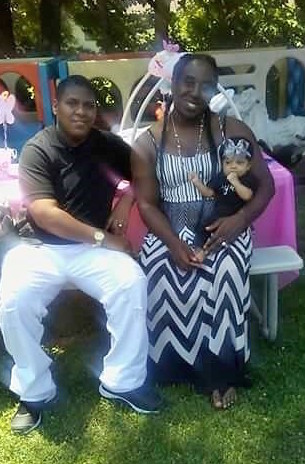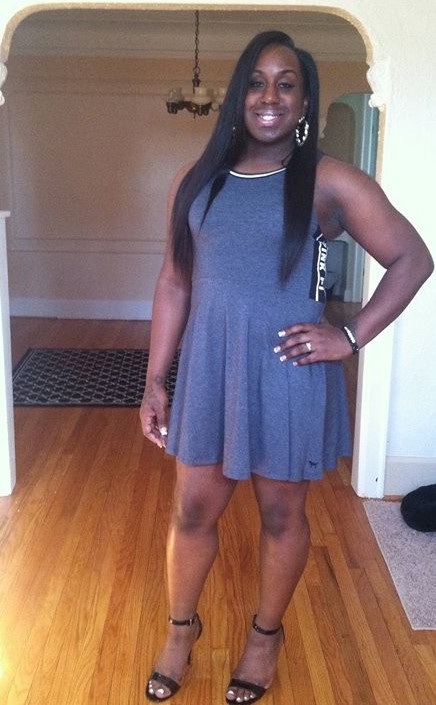As a new mother, this transgender woman has faced unique challenges that inspired a new direction for her activism.
This is part of a story series about the lives of transgender people. Read the introduction here.
 When Racquelle Trammell found out that she and her fiancé, Liam Johnson, were expecting their first child, it was a joyous occasion. They knew they wanted to have a child together, even though it meant making sacrifices other couples might not have to make.
When Racquelle Trammell found out that she and her fiancé, Liam Johnson, were expecting their first child, it was a joyous occasion. They knew they wanted to have a child together, even though it meant making sacrifices other couples might not have to make.
For Trammell, conceiving meant going off the hormone replacement therapy (HRT) she’d started a couple of years earlier, as part of transitioning from the male gender she’d been assigned at birth. For Johnson, it meant being subjected to scrutiny as a transgender man who is trying to get pregnant.
But it was a choice they both felt determined to make, Trammell says, especially after initially failing to conceive.
You don’t know how badly you want a child until you have something in life that takes it away from you. So I’m weighing what’s more important. I used to heavily take medical interventions to get to this point as a trans woman. But now transitioning looks a little different to me. I frame my mind around transitioning as a state of mind — of existence.
Four months ago, the couple welcomed their daughter, Aspen Peyton Johnson, into the world. Although many couples go through challenges with pregnancy, Trammell and Johnson faced unique circumstances.
According to Trammell, it wasn’t easy finding a doctor who was prepared to work with a transgender couple that wants to be parents.
“It’s hard for them to understand how that looks with identity and associating with people through their identity and not their parts when it comes to the whole birthing process,” Trammell says. “The names they want you to place on the birth certificates — all the processes need to be updated to reflect people as who they are.”
The first doctor they consulted with asked if Trammell and Johnson were transvestites, and they never went back.
“I don’t think he meant any harm,” Trammell says, “but that was his reaction to identifying trans people.”
After meeting with a number of doctors, the couple found one who was a perfect fit, Trammell says.
The most important thing was we remained true to ourselves. I’m big on speaking up for myself. A lot of times, when you’re in spaces with policies that are a certain way, they’re not open to changing. I talked to her about my concerns, and what we did not want to happen as far as making our delivery horrible, and she was fine with that. She was very progressive and knew this care and experience wasn’t about her or her views.
Johnson’s insurance company balked at first about covering his labor and delivery, because of his legal identification. That’s a challenge many trans people face — having their insurance refuse to cover a service they need because of their biological gender, such as trans men needing cervical cancer screenings if they still have a cervix. This is improving with strengthened protections under the Affordable Care Act, but there’s much more work to be done.
Fortunately, the hospital worked with the couple to make sure the labor and delivery were covered by Johnson’s insurance. The couple also struggled initially to get coverage for Aspen, but that’s been resolved, too.
It was difficult talking to insurance people, because of how invasive they are about asking probing questions and demeaning people in their own experience and existence.
That’s a big thing I want people to know. I’m sure there are going to be a zillion trans people who become parents. If people don’t have this dialogue about how people made them feel and their treatment, they’re not ever going to change.
Partly because of this experience — which Trammell explored with other trans couples in search of support — she is going back to school to earn a bachelor’s degree in community awareness.
Her dream is to start an organization centered around trans families, helping them gain access to care and resources to promote healthy visibility and inclusion.
Trans people have to be included in the whole family structure of how society treats families and their norms. Talking with other couples about the way the media depicted them and demeaned them into telling their stories really shaped my mind around the work that needs to be done. It needs to be told the way you tell it. For someone to change that narrative is detrimental to how people view you as people.
This is also something Trammell knows from personal experience. Although she didn’t begin transitioning medically until two years ago, she began presenting as female 10 years ago, when she was 19 years old. But she knew long before then that she didn’t identify with the male gender she was assigned at birth, even though she had no language to explain it.
I remember growing up and people constantly asking was I gay. And the misconception was never hearing that word in a predominantly urban kind of heteronormative family. I didn’t want to identify with something I wasn’t conscious of what it meant.
The sad reality is a lot of trans people have to come out twice. You think your sexual orientation is indicative of who you are, then you find out about gender identity later or when you have an epiphany about yourself.
Trammell says she didn’t find out about the transgender community until she left home, moving in with a cousin at age 15. She started her own journey of self-discovery then, and began learning about sexual orientation and gender identity. At the time, she says, the Ruth Ellis Center in Highland Park was a very helpful resource.
 Although others placed her in a hyper-feminine category, Trammell says she “veered the line” of androgynous and being accepting of her femininity. But as she began to meet more transgender people, her understanding deepened.
Although others placed her in a hyper-feminine category, Trammell says she “veered the line” of androgynous and being accepting of her femininity. But as she began to meet more transgender people, her understanding deepened.
“It became easier to connect the dots and learn the difference between sexual orientation and gender identity,” she says. “I asked some women about how they formed their own identities and it just made sense. It was like an epiphany moment.”
When Trammell began presenting as female she was in college, studying for her associate’s degree in art. But she was frequently taunted, misgendered and intimidated. She dropped out and re-entered school a number of times. “It was hard to focus on school while being mocked and made fun of,” she says.
Even back then, she says bathroom access was a problem — although not for people who didn’t know her. She had no problem using the women’s restroom when the people around her were strangers. But those who knew she was transitioning fought against her using the bathroom that matched her gender identity.
Trammell eventually graduated last year, a long process made even more challenging after she legally changed her name. Applying for financial aid became a struggle because there were two names associated with her Social Security number, which made it look like identity theft or fraud. But she persevered and graduated.
An activist at heart, Trammell used to work with LGBT homeless people. She currently works for an organization that provides care to the elderly.
“I wanted to become more of a well-rounded activist,” she says. “I wanted to get over my ageism, my own personal bias, and challenge myself.”
As she prepares to return to school, Trammell is basking in the joy of her family, which includes the family and friends who have accepted her transition.
You always have those who love you for who you are. You keep those with you. You have to be okay with the relationships that fade away. You have to respect them for who they are. There’s a thing about trans women loving trans men that has a lot of scrutiny behind it. But love resonates from the heart. It doesn’t look like a certain gender or sex.
Trammell is eager to provide support to families like hers, and offers some words of advice.
“Educate yourself and advocate — be an ally to a trans person you know or heard about,” she says. “If you can do neither, just respect not trying to impose your views on a trans person and police their identity in their bodies.”
Read all the stories in this series HERE.
[Photos courtesy of Racquelle Trammell.]



